Contributory members are able to log private notes and comments about each site
Sites Anne T has logged. View this log as a table or view the most recent logs from everyone
Beckermet Ancient Crosses (St Bridget's)
Date Added: 4th Jun 2017
Site Type: Ancient Cross
Country: England (Cumbria)
Visited: Yes on 24th Oct 2014. My rating: Condition 3 Ambience 4 Access 5
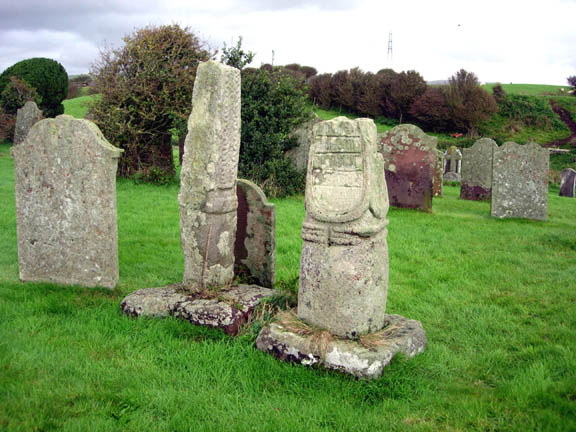
Beckermet Ancient Crosses (St Bridget's) submitted by astronomer on 13th Oct 2006. The squat Saxon cross at Beckermet is stylistically very similar to Eliseg's pillar at Llangollen and to others in the Lyme, the moorlands fringing the eastern border of Cheshire and Staffordshire with the Peak District, especially between Macclesfield and Leek. The western side of the Beckermet cross, shown here, displays a panel thought to carry Viking runes carved on its surface.
(View photo, vote or add a comment)
Log Text: Ancient crosses, St. Bridget’s Church, Beckermet: Despite having been given directions by the vicar of St. John’s, Beckermet, we had several attempts at finding St. Bridget’s, but got there in the end. We need to take a left hand turn off the main road through Beckermet opposite Crofhouse Farm into a small housing estate, then taking the right hand turn marked ‘St. Bridget’s Church’ a few hundred yards down this lane and following this narrow lane down to the church. By this time, the wind had got up and whilst it wasn’t particularly cold, it wasn’t a day to linger.
There was some parking outside the church, which looked virtually derelict, although there were some recent burials in the churchyard, with fresh flowers and containers of water by the church door. The door to the church was open, shut only by a wooden latch which pivoted on a central nail.
Both cross shafts were to the south of the church, looking onto open countryside, with the towers of Seascale/Sellafield in the near distance.
The taller of the two cross shafts, Beckermet St. Bridget 02, dates from the tenth to eleventh century, and is made of St. Bees sandstone. According to the ASCorpus notes, the three encircling mouldings around the cylinder are rare.
I found the shorter of the two cross shafts fascinating, with the remnants of an inscription on its western face.
Apparently, there was a third fragment, part of a cross-head, which is now under plaster in the east wall of the chancel.
Langdale Axe Factory
Date Added: 4th Jun 2017
Site Type: Ancient Mine, Quarry or other Industry
Country: England (Cumbria)
Visited: Yes on 11th Aug 2015. My rating: Condition 3 Ambience 5 Access 3
Langdale Axe Factory submitted by Thorgrim on 15th Nov 2003. The Langdale Pikes in Great Langdale.
(see article on Langdale Axes)
(View photo, vote or add a comment)
Log Text: Mickleden Way, finding pointers to the Pike O'Stickle Axe Factory: I was lucky enough to win a copy of Gabriel Blamires book in a Portal photographic competition. It arrived just in time for our trip over to the Lakes on 10th/11th August. We followed Chapter 4: The Mickleden Way, having parked at the National Trust pay and display car park next to the Old Dungeon Ghyll Hotel, and headed up behind the pub onto the stoney footpath into the hills.
This is a beautiful and easy walk with Mickleden Beck in the valley to the left hand side and Langdale Fell with Pike O’Stickle to our right. We were passed by a number of small climbing parties coming back the other way.
We found boulders 4.1 to 4.7. We had intended finding more but dusk stopped us in our tracks and had us retracing our steps back to the Hiker's Bar at the hotel The Pike O’Stickle Pentagon was perhaps the most dominant and impressive stone. To be found at NY 2738 0640 it stands out proudly on the hillside and is one of the more convincing markers/pointers. There has been some recent activity around both sides of the stone, with gullies being made to channel water off the hillside around it, hence it’s a bit tricky to get up to. From the banks of one of these gullies I picked up a lump of shiny black stone (now dried it is a dull green-grey with light brown inclusions) which was incredibly sharp. We later identified it as a piece of stone used for the axes, so it now sits proudly on my window ledge.
As our walk continued there were so many stones and stony outcrops that we started to wonder how Gabriel Blamires had chosen the pointers he did, as there were others which equally stood out in the landscape. He has obviously done an immense amount of research to check everything out. I did get excited at boulder 4.4 as bending down to retrieve the lens cap for my camera, I noticed that the top profile of the boulder seemed to echo the pattern of the peaks above.
Following the book to the letter, and thankful for our GPS, we got to boulder 4.7 before spotting what looked like an area of cairns.
There are many more boulders detailed in Gabriel's book, along with some stunning walks/ways and I really look forward to finding out more.
I do agree with rich32 that you would have needed ropes and parachutes to attempt to get up to the axe factory!
Hurl Stone
Date Added: 31st May 2017
Site Type: Standing Stone (Menhir)
Country: England (Northumberland)
Visited: Yes on 30th Aug 2014. My rating: Condition 2 Ambience 3 Access 4
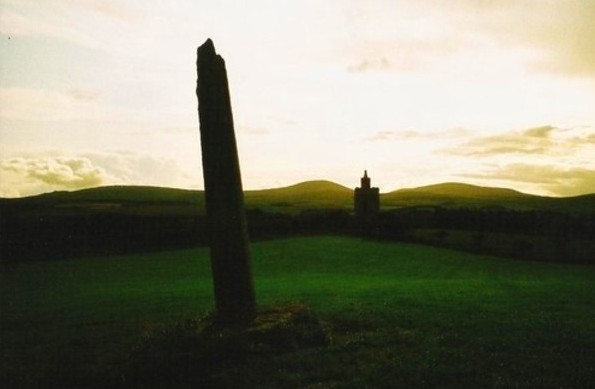
Hurl Stone submitted by Bladup on 30th Dec 2013. The Hurl stone, In the background is a folly built in 2000.
(View photo, vote or add a comment)
Log Text: The Hurl Stone, Newtown, Northumberland. Second visit: Saturday, 30th August 2014. Armed with a letter from the landowner allowing us access, we set off back to the Hurl Stone before the weather turned.
The farmer was busy herding sheep down the road to the field next to the Newtown Mill standing stone. He was using an army style buggy and 4 sheep dogs, which was fascinating in itself. Having watched this, we drove the 100 yards further up to farm at Newtown and bumped up onto the grass verge next to the gate leading into the Hurl Stone field.
It was a longer walk than it looked, through lush ankle high grass to the top of the slight hill. The tall Hurl Stone commandeered the horizon, but I was only about 20 yards away when I realised it had been concreted in. It looked as if at some time it had toppled and been recently re-erected (but if they’d done this, why let the stone lean, unless it was to give the impression it had indeed been hurled? Sorry, this is me being sceptical). This took a little of the shine off seeing the Hurl Stone, but my goodness, what a 360 degree view, which I’ve tried to represent in the photographs submitted to the Portal.
The face of the stone facing the recently built tower (I’m told this is used as a conference centre, but haven’t been able to verify this yet) looks as if it has broken at some time in the past. The quartz crystals within the stone sparkled in the sunlight. There was some, but not much, graffiti carved into it.
The landowner, who resides nearby, opens his gardens under the National Garden Scheme, and according to an archived article in the Hexham Courant, our local paper, has a 14th century chapel, a crusader tomb and two grave slabs belonging to Knights Templar, so I’ll be looking out for dates to go and see these other treasures.
I’m going to write to thank the landowner for allowing us access.
First visit, August 17th 2014: Driving down the road southwards past the hamlet of Newton, we at first only saw the recently built tower in the field to our right. Driving a little further on, we stopped at the standing stone on the opposite side of the road, just below Ewe Hill, to take photographs. When we turned the car and drove back up the road, the Hurl Stone appeared like a sharp needle, just below the top of the hill.
It’s proximity to the modern tower seems suspicious (we immediately asked ourselves if the stone had been moved to provide a good view of it from Liliburn Tower, the landowner’s house, as from the maps, the modern tower and the stone seem to be in direct alignment?).
There were no public footpaths to the stone, so I stopped at the field gateway and took a photograph. I have since written to the landowner to ask for permission to walk to the stone across the field.
Harbottle
Trip No.28 Entry No.7 Date Added: 30th May 2017
Site Type: Modern Stone Circle etc
Country: England (Northumberland)
Visited: Yes on 28th May 2017. My rating: Condition 3 Ambience 5 Access 4
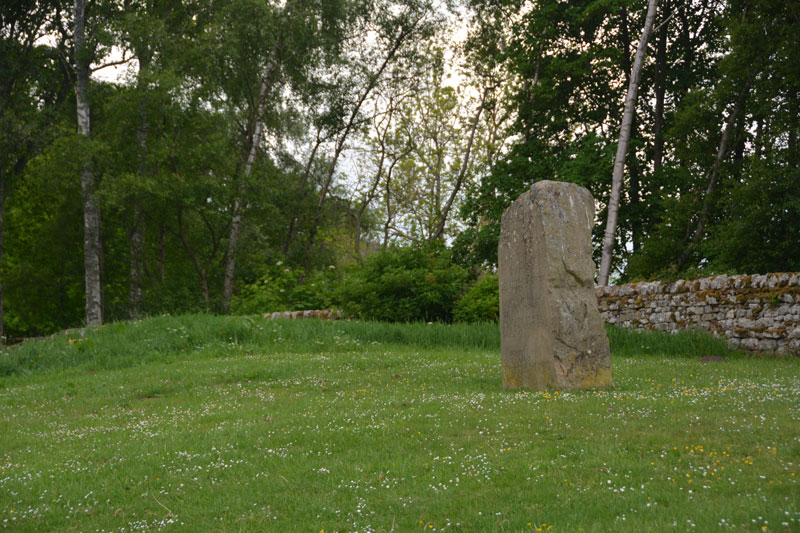
Harbottle submitted by Anne T on 30th May 2017. This modern standing stone can be found on a grassy bank at the western side of the car park for the castle.
(View photo, vote or add a comment)
Log Text: Harbottle Modern Standing Stone/Castle: From Holystone, we passed through Harbottle to get back to the A68, so stopped to look at the castle. The site is lovely.
I spotted the modern standing stone to the west of the car park. The standing stone is inscribed with words:
The Sad Castle
Who Made me/Into a ruin/like an old city?
Was it the soldiers who rode out on horseback?
Was it my old enemy the Scots?
Or was it those Border Reivers?
Perhaps it was just the centuries passing.
Felicity Lance
Apparently there are supposed to be 2 poems, the above by Felicity Lance, another by Robert Corley from Harbottle School, carved into the stone by local stonemason David Edwick. I walked all around the stone, even photographing the other faces to see if anything came up on the camera, but only saw the one poem.
The Pastscape record says there could have been a pre-Conquest fortress on the site. The motte is very steep, and a walk around the moat/outer ditch was charming. Walking into the ruins from the eastern side, there are lots of lumps and bumps of the remains of walls and buildings. Very enigmatic. Really pleased to have been here.
Outer Golden Pot (Otterburn)
Trip No.28 Entry No.4 Date Added: 29th May 2017
Site Type: Marker Stone
Country: England (Northumberland)
Visited: Yes on 28th May 2017. My rating: Condition 2 Ambience 4 Access 5
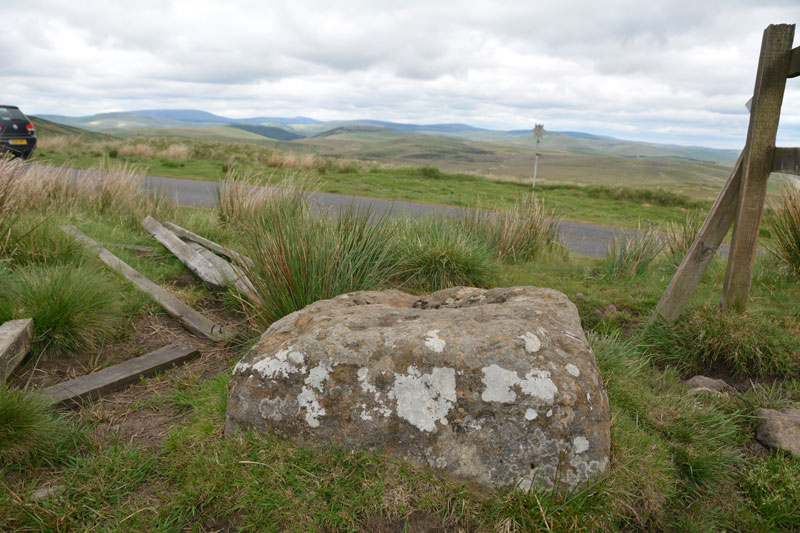
Outer Golden Pot (Otterburn) submitted by Anne T on 29th May 2017. From it's eastern side, the Outer Golden Pot has wonderful views over Upper Coquetdale.
(View photo, vote or add a comment)
Log Text: Outer Golden Pot (Otterburn): What stunning views across to Upper Coquetdale from here. No wonder the site is marked as a view point on the Otterburn Ranges Access Map. The fencing surrounding this Golden Pot has been broken on three sides, so it’s possible to appreciate its form more fully than the Middle Golden Pot.
The base is smaller than the Shitlington Cross but is about the same size as many of the Anglo Saxon Cross Bases we’ve seen in and around churches in North Yorkshire.
As I stepped back towards the road to photograph the base, I saw what looked like a cart track running diagonally up the hillside, crossing under the road and carrying on in a north-east/south-west direction. Andrew pointed out that if I moved a bit further over, I could see the second ditch, so this was the old course of Dere Street, now metalled and called ‘Roman Road’.
After stopping to photograph this stone, we went in search of Ridlees Cairn and Bushman’s Crag, to the south east of these intriguing cross bases.
Inner Golden Pot (Otterburn)
Trip No.28 Entry No.2 Date Added: 29th May 2017
Site Type: Marker Stone
Country: England (Northumberland)
Visited: Yes on 28th May 2017. My rating: Condition -1 Ambience 4 Access 5
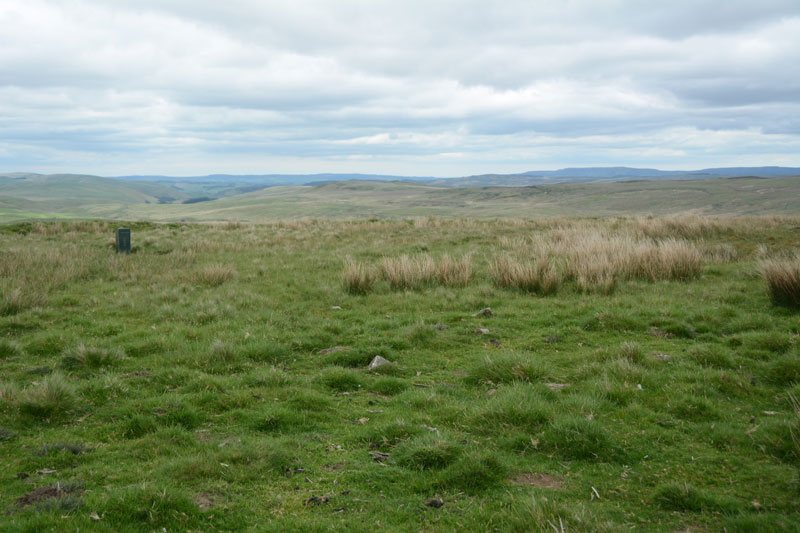
Inner Golden Pot (Otterburn) submitted by Anne T on 29th May 2017. At the site of the Inner Golden Pot there were only broken sandstone pieces and modern army equipment. I thought it was worth stopping to look to see if anything remained, especially as it was a nice viewpoint.
(View photo, vote or add a comment)
Log Text: Inner Golden Pot, Otterburn Ranges: No trace of this cross base can be found, but I couldn't resist having a look. There were some small sandstone pieces around the grid reference point, together with a funny green box - presumably some military equipment. A great viewpoint across to Upper Coquetdale.
Middle Golden Pot (Otterburn)
Trip No.28 Entry No.3 Date Added: 29th May 2017
Site Type: Marker Stone
Country: England (Northumberland)
Visited: Yes on 28th May 2017. My rating: Condition 2 Ambience 4 Access 5
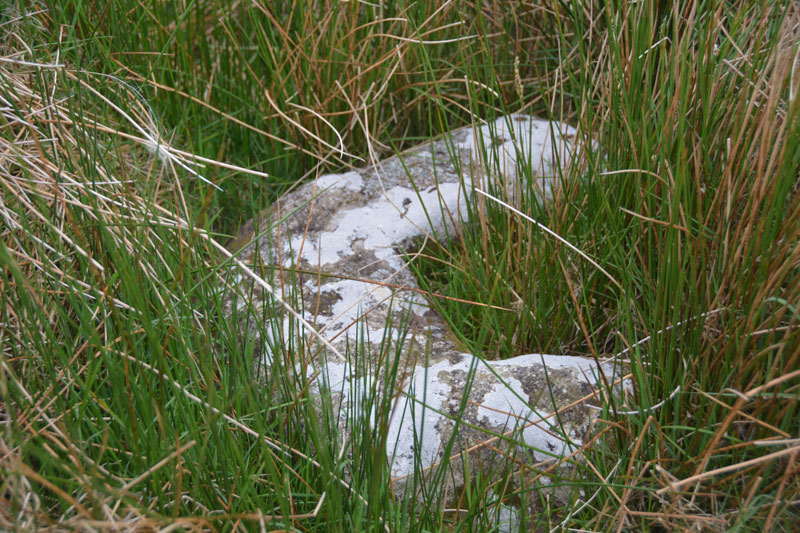
Middle Golden Pot (Otterburn) submitted by Anne T on 29th May 2017. The Middle Golden Pot from a different angle.
(View photo, vote or add a comment)
Log Text: Middle Golden Pot (Otterburn): Fenced off behind a nice, neat fence with a label “Do not feed the cross base” – no seriously, “Archaeological Area”. This stone was mostly hidden under the marsh grass and I struggled to get decent photographs as the camera kept focusing on the grass rather than the stone. Whilst I snapped away, Andrew went off wandering along the top of Dere Street off to the east – very well defined with a visible ditch on either side. The modern metalled road (imaginatively called ‘Roman Road’ turns a left-handed right angle here, as the course of Dere Street changes. Being just below the brow of a hill, I wondered why the stone was placed here, but looking at the change of direction of the road, it made sense. Stepping behind the stone and looking north-west, Dere Street could be seen running up hill, joining with the section to the east of the stone.
Ridlees Cairn
Trip No.28 Entry No.5 Date Added: 29th May 2017
Site Type: Cairn
Country: England (Northumberland)
Visited: Yes on 28th May 2017. My rating: Condition 3 Ambience 4 Access 4
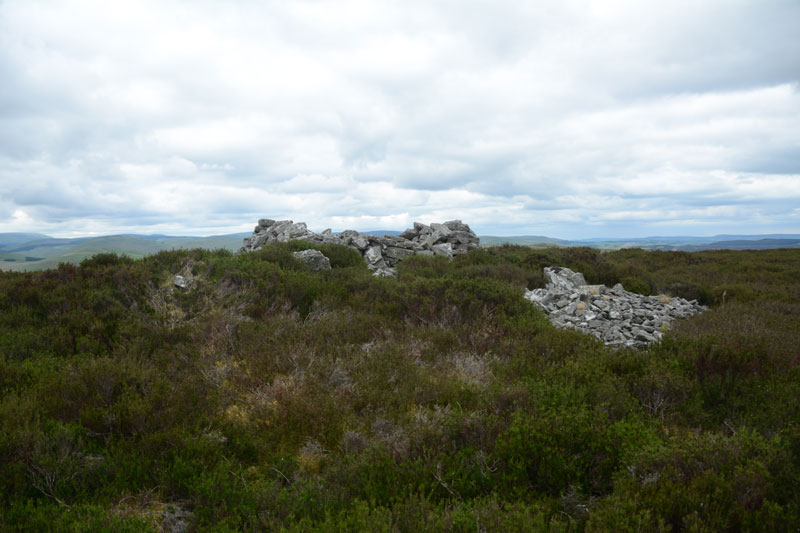
Ridlees Cairn submitted by Anne T on 29th May 2017. Approaching Ridlees Cairn from the east. It is a substantial cairn, made up of small and medium sized stones.
(View photo, vote or add a comment)
Log Text: Ridlees Cairn, Otterburn Ranges: This is one of the times I’ve actually made it up to a Trig Point (usually too steep a climb or too high a drop for my liking), but this was easy. Ridlees Cairn was actually 250 metres to the east north east of Bushman’s Crag, but I’m sure some people may visit the crag thinking it is the cairn. The views here are impressive. No wonder the military have a bunker hidden just up the road, and possibly hollowed out the centre of the cairn for use as a machine gun nest (apologies if this is not the case, this is just husband guessing).
Parking at the cairn (the metalled roads had deteriorated from this point and were very narrow), we walked to the east of the cairn and pushed through the heather to reach it.
It is substantial, with a flattened stone kerb around it, partly hidden by heather, partly by tumbled stones.
St Mungo's Well (Northumberland)
Trip No.28 Entry No.6 Date Added: 29th May 2017
Site Type: Holy Well or Sacred Spring
Country: England (Northumberland)
Visited: Yes on 28th May 2017. My rating: Condition 4 Ambience 4 Access 5
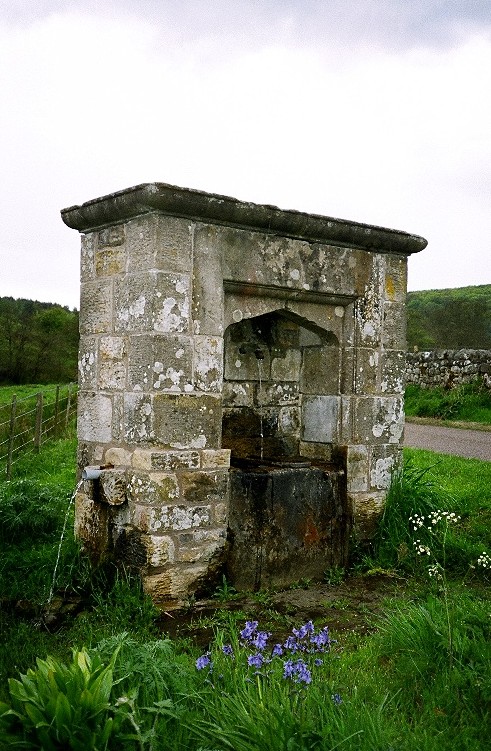
St Mungo's Well (Northumberland) submitted by KiwiBetsy on 27th Nov 2004. St Mungo's Well amidst well watered wildflowers.
(View photo, vote or add a comment)
Log Text: St. Mungo's Well, Holystone, Northumberland: We’d already visited the lovely Lady Well on 8th September 2013, but stopped to look at this one, which is at the side of the Coquet River. Sitting by the right hand side of the road just before entering the village from the Otterburn Ranges, just before the corner of the road leading up to Holystone Priory Farm and the footpath up to Lady’s Well.
The grass and weeds had grown right up to the well, although there was a small track to the well basin, showing a few other people had visited.
I did taste the water, which was clear, but didn’t taste of any particular mineral. The flow of water was strong (but not as strong as St. Cuthbert’s Well in Bellingham), indicating it might be artesian after a long spell of very dry weather in this part of the world.
I hadn’t done any research on this well before visiting, just passing by on the spur of the moment. Pastscape is dubious about this being a holy well. The shrubbery around the well hid the overflow pipe at the burn side of the structure, and I wished I had looked for the conduit at the village green. Another trip to this beautiful part of the county is called for.
Bellshiel Law
Trip No.28 Entry No.1 Date Added: 29th May 2017
Site Type: Chambered Cairn
Country: England (Northumberland)
Visited: Yes on 28th May 2017. My rating: Condition 3 Ambience 5 Access 5
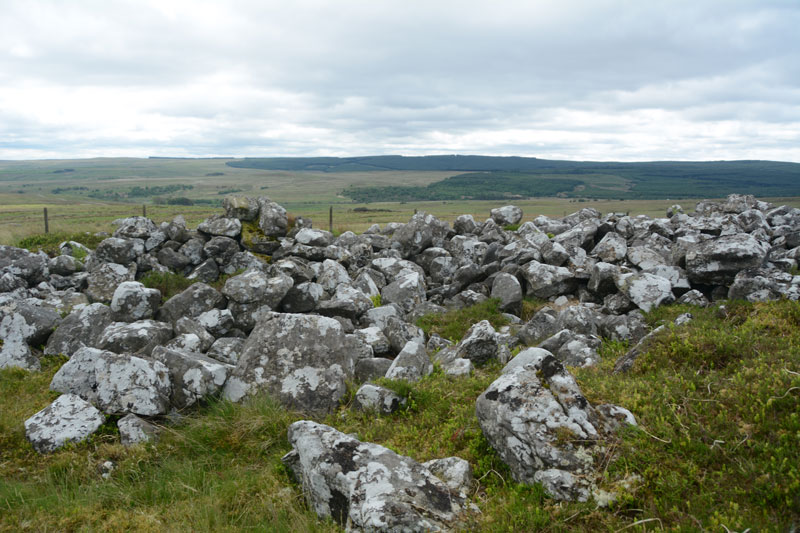
Bellshiel Law submitted by Anne T on 29th May 2017. The northern side of the cairn is partly earth and turf covered for the first few feet. Whether this is just build of earth through the prevailing wind blowing it in or the remains of a purpose built covering was difficult to tell.
(View photo, vote or add a comment)
Log Text: Bellshiel Law, Otterburn Ranges: It felt very strange driving onto the Otterburn Ranges with no red flags flying and no military around – I felt like I was trespassing. The ranges are absolutely huge – the Access map and Guide says they cover 90 square miles. We saw 3 other cars all day, 2 of those from a long distance, and 3 cyclists.
Bellshiel Law can be reached by a military road approx. 2 km on the western side of Rochester. The start to this road system is quite complex, but we headed left and left again taking us up over Bellshiel Road. AT NT 81079 01161 the road forks. At this point take the right hand fork. The cairn comes into view on the right hand side of the road. There is a small parking area underneath a natural crag at NT 81267 01260. My first reaction was “Wow, this is huge”.
Narrow trackways through the grass lead you to the cairn, which is fenced off and labelled “Archaeological Area” and “Out of bounds to Troops”. A gate (difficult to open with all the marren grass around it, but managed to squeeze through) lets you into the cairn. It is large – Pastscape recording it as 367 feet long and 52 feet wide at its eastern end, with a maximum height of 6ft (1932 measurements), which translates to 109m long, varying in width from 8.8m at the west end to 15m at the broader east end, maximum height of 1.6m (1994 English Heritage Scheduling).
Someone has built a sheep pen on the southern side, presumably using stones from the cairn. Walking along the stones at the side of the cairn, largely turf covered, I spotted a number of circular ‘rooms’ inside the cairn, with one oblong shape. Called a long cairn by Pastscape, they record “the cairn on the whole, was found to contain no structural remains of an earlier period (ie cists, chambers, revetments internal structures ….. and cannot be dated any earlier than Early Bronze Age and possibly later.”
Great views to the south to the River North Tyne Valley and beyond.
St. Mungo's Well (Simonburn)
Trip No.27 Entry No.1 Date Added: 27th May 2017
Site Type: Holy Well or Sacred Spring
Country: England (Northumberland)
Visited: Yes on 25th May 2017. My rating: Condition 2 Ambience 2 Access 4
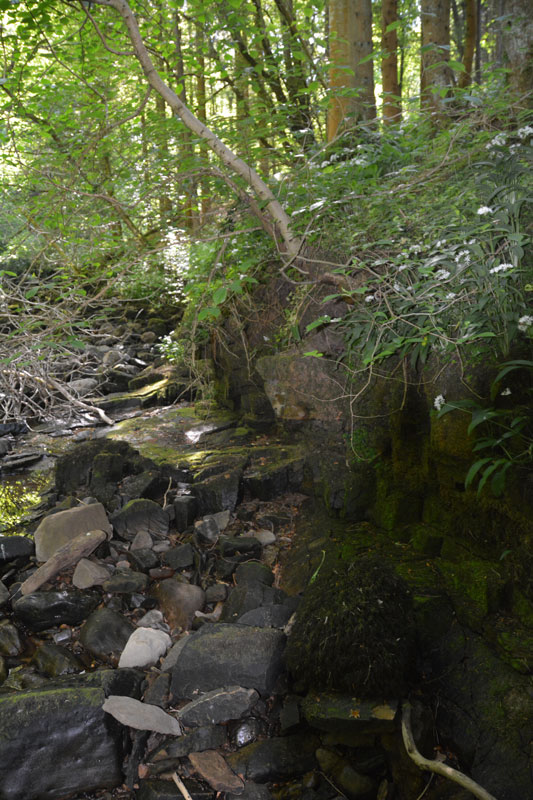
St. Mungo's Well (Simonburn) submitted by Anne T on 27th May 2017. This is the very tumbledown structure at the grid reference for the well. It hasn't been used for a very long time, and my husband wasn't convinced he'd found the right place, but it was the only structure that he could find around.
(View photo, vote or add a comment)
Log Text: St. Mungo's (Mugger's) Well, Simonburn: Our first stop on this hot, sunny day. Parking at Simonburn tea-rooms, we asked if it was OK to leave the car there whilst we walked round the village, and were told it was alright (there is another car park in between the south wall of the churchyard and the forest). I would thoroughly recommend sitting out in the tea-room gardens with a cup of tea and iced water, as they have very comfortable garden furniture and it’s a very quiet spot.
It was a relief to get into the cool of the forest leading down to the Crook Burn, which hardly had any water in it at all after so little rain for weeks and weeks. It was possible to walk on the stream bed.
Following the tracks through the forest to the burn, there is little or no sign of the well. There appears to be an flattened area which might represent an old path, running along the ledge at the top of the burn on its north side, but this has been long out of use. It’s also a three foot plus drop onto the bed of the burn at this point.
Lacking the confidence to walk along the large slippery blocks of stone along the stream bed, I handed the camera to my husband and went exploring the forest tracks. Andrew came back having seen the remains of a structure, long disused, at the grid point indicated for the well, so we are not entirely convinced this is it.
Shitlington
Trip No.27 Entry No.4 Date Added: 27th May 2017
Site Type: Marker Stone
Country: England (Northumberland)
Visited: Yes on 25th May 2017. My rating: Condition 3 Ambience 4 Access 4
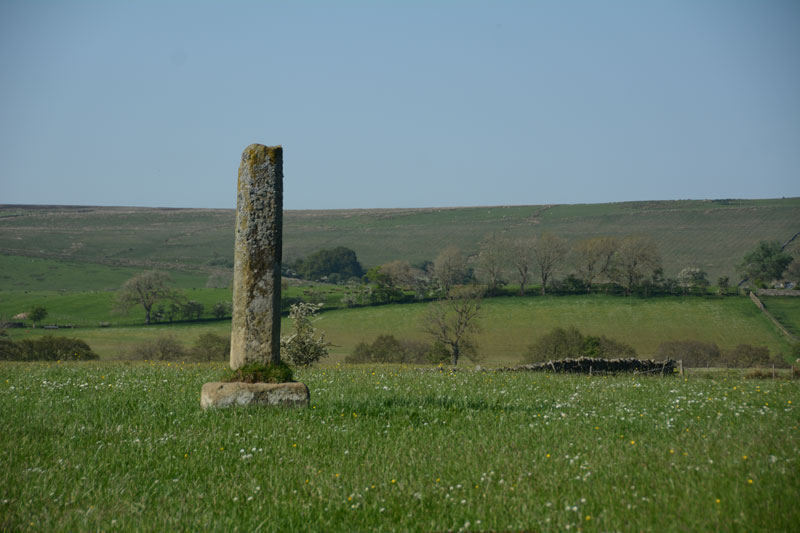
Shitlington submitted by Anne T on 27th May 2017. First view of the Shitlington Cross, walking across the field from the make-shift stile across the stone wall. The views across the surrounding moors are lovely.
(View photo, vote or add a comment)
Log Text: Shitlington Cross, near Bridge House (south of Bellingham): We stopped here because we were passing on the way to the Bridge House/Hetherington Farm homestead and it was marked on the OS map as a ‘cross’. It looks like an old standing stone on a sandstone cross base, similar to the Hurl Stone near Ewe Hill/Lilburn Grange (http://www.megalithic.co.uk/article.php?sid=35235but with a genuinely older base (not just reset in concrete).
Someone had made a stile over the wall into the field. As this was just pasture, we kept to the edge of the field to have a closer look. Very enigmatic, just sitting in the middle of the field with nothing around it.
Checked the top – there was no socket on top, just weathered. It was worth stopping to look because of the wonderful views over Watergate Moor, Wark Common and Broughy’s Hill. Could have sat here all day in the sunshine.
St Cuthbert's Well (Bellingham)
Trip No.27 Entry No.2 Date Added: 26th May 2017
Site Type: Holy Well or Sacred Spring
Country: England (Northumberland)
Visited: Yes on 25th May 2017. My rating: Condition 3 Ambience 4 Access 5
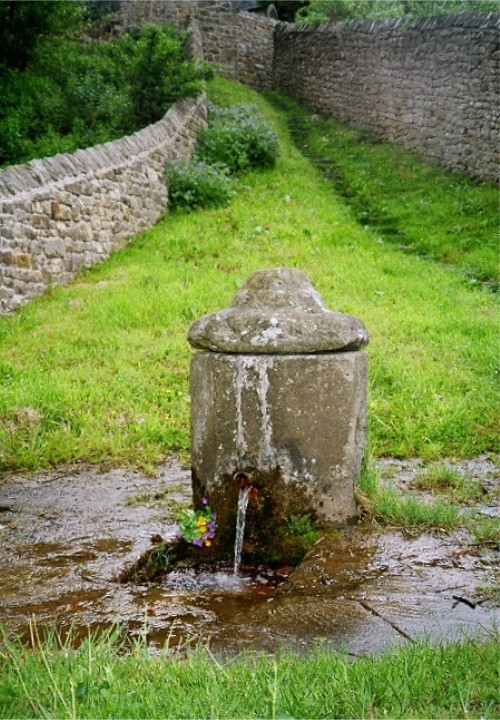
St Cuthbert's Well (Bellingham) submitted by KiwiBetsy on 11th Dec 2004. St Cuthbert, a noted dowser, found and dedicated this abundant spring of clear, pure water quite unlike the brackish marsh water of the area.
Today, the water is contained in a picturesque Georgian pant with it’s ever flowing spout directing the water down through a grill and away to the River Tyne. The upright pant was considered a vast improvement over the older dipping well provided water pressure justified building one.
The water is still used in the church for baptisms. The lo...
(View photo, vote or add a comment)
Log Text: Cuddy's Well (St. Cuthbert's Well, Bellingham): Parking in a small layby at NY 83833 83303, just opposite Manchester Square side road, we headed off to the church. The church was open, so we popped in to have a look. It looked relatively modern, but a plan hooked on the wall told us the sanctuary and chancel dated from the 13th century. Research this afternoon on British Listed Buildings said the church was extensively remodelled in 1609 and bell cote added in 1865. The stone barrelled roof was certainly interesting.
There was a marked grave ‘the lang pack’ in the churchyard, which the ‘A Church Near You’ website says is “the 'Long Pack' grave of a would be house-breaker who was killed by the butler of the house he was trying to rob.”
The well was mentioned briefly on the wooden plaque containing points of interest. To find this, we needed to go out of the church, walk south by the Black Bull, then turn right along the Pennine Way, following the eastern external wall of the churchyard. The path narrowed between two stone walls, but turning round a corner we encountered shallow steps leading down a bank, and there was the well at the bottom. We could hear water gushing from half way down the steps. The water rushed through the grill into the pool below, foaming up with the pressure. I did taste the water; it was fresh, but had no specific taste of any mineral.
On the eastern side of the current well structure there was another hole in the stone, and looked as if at some point either another spout came through, or the current spout had been moved.
Walking back up to the car, we noticed signs for the well and riverside walks from the main square (Manchester Square) in the town, which could be used for disabled access. I didn’t realise until I looked at UK Grid Reference Finder how close we had been to the North Tyne River, as the view was blocked by a very overgrown part of the cemetery.
East Steel Farm
Trip No.27 Entry No.1 Date Added: 26th May 2017
Site Type: Modern Stone Circle etc
Country: England (Northumberland)
Visited: Yes on 25th May 2017. My rating: Condition 3 Ambience 3 Access 5

East Steel Farm submitted by Andy B on 24th Nov 2001. East Steel Farm Stone Circle
(View photo, vote or add a comment)
Log Text: East Steel Modern Stone Circle, Near Beltingham, Northumberland: From Beltingham, the further we drove out into the fells, we kept seeing bright yellow ‘Art Gallery Open’ signs. Long way to go for an art gallery, but a lovely drive. Note for future visitors – follow these signs!
As we pulled up to the lane leading down to East Steel House, marked by the signpost (see below), Dennis Kilgallon’s van was coming up to the road junction, signalling to turn right along the minor road. We indicated to go left and we passed each other. Parking by the circle, I hopped out with the camera, not realising Dennis had parked up and came across to speak to us. “Just taking a look?” he asked, “It’s a folly – built 10 years ago”. I thanked him kindly as he got back into his van and drove off. What a lovely place for an art gallery.
I counted 14 stones in the circle, most looking like reused gateposts, some of them leaning, largely built inside an old boundary, now just an arc of raised earth and stone in the ground topped in places by old, crooked, atmospheric hawthorn trees. Two of the stones were placed nearer to the track, outside the boundary - the circle wasn’t circular.
There was one really huge stone, presumably meant to be the heel stone. I wondered how it got there. My husband grunted and said “truck and crane probably.” At this point, a man in black was pelting up the track towards us, and I thought this was the farmer coming to warn us off, but no, it was a runner, who bid us good evening on his way past.
After 10 minutes or so appreciating the calls of the curlews on the surrounding fells, we headed off back to Beltingham and home.
Walwick Fell
Trip No.26 Entry No.1 Date Added: 22nd May 2017
Site Type: Ancient Village or Settlement
Country: England (Northumberland)
Visited: Yes on 21st May 2017. My rating: Condition 2 Ambience 4 Access 4

Walwick Fell submitted by Anne T on 22nd May 2017. Looking over at the two banks to the south west of the main structure.
(View photo, vote or add a comment)
Log Text: Walwick Fell Farmstead, near Hexham: This settlement is not far from Tower Tye, where the Tynedale North of the Wall Archaeology Group used to meet before the surveys. Turning south on the un-named road towards Whinney Hill, we parked in a small layby at the edge of the wood on the east side of the road, opposite the gate into the field containing the settlement. The footpath runs diagonally north west across the field, with the settlement to the right hand side towards the top of the hill, but with bullocks grazing in the field, looking very interested in coming over to us, we gave them a wide berth and approached the settlement from the east.
The settlement appears as a series of defined banks on the slope of the hill, with gorse bushes to its south-western side.
In the wood behind the stone wall to the north of this settlement lies the remains of a Roman camp, but it has been so disturbed by forestry works it is not really possible to see anything.
There are the clear remains of two hut circles, with their foundations built into the back of the slope. The banks are all turf covered and easy to make out. The site has wonderful views to the west, south and east (south to the South Tyne Valley), although it is in a sheltered spot just below the brow of the hill.
Looking on UK Grid Finder when I got home, it is impressive how much of the site can be made out on the aerial image.
There is a well marked on the OS map in the lower part of the field, although it was not evident when we made our way back to the gate.
Cross Well (Linlithgow)
Trip No.25 Entry No.3 Date Added: 21st May 2017
Site Type: Holy Well or Sacred Spring
Country: Scotland (West Lothian)
Visited: Yes on 18th May 2017. My rating: Condition 4 Ambience 3 Access 5
Cross Well (Linlithgow) submitted by KiwiBetsy on 17th Oct 2006. Site in West Lothian
The present Cross Well stands in the High street of Linlithgow just outside the lane that leads to Linlithgow Palace.
(View photo, vote or add a comment)
Log Text: Cross Well, Linlithgow: From the Knock Modern Stone Circle, we set off towards the Gogar Stone. Passing through Linlithgow (we plan on going to see the Palace and nearby Hopetoun House) another day.
There was no market today, so I persuaded my friend to quickly stop which I got a proper photograph of the well! (Note the friend's car hiding behind the structure!)
Physic Well (Corstorphine)
Trip No.25 Entry No.5 Date Added: 21st May 2017
Site Type: Holy Well or Sacred Spring
Country: Scotland (Midlothian)
Visited: Yes on 18th May 2017. My rating: Condition 3 Ambience 4 Access 5

Physic Well (Corstorphine) submitted by feorag on 31st Aug 2006. The overgrown remains of the Physic Well, Corstorphine. Photographed 23rd October 2005.
(View photo, vote or add a comment)
Log Text: The Physic Well, Corstophine, Edinburgh: Pulling up on the northern section of Dunsmuir Court from Ladywell Road, I thought we’d spotted the well head under the trees between the houses and the main road, but this turned out to be a milestone!
Thankfully having the image of the well from the Portal, we followed the Court round to the garden at the back, and found the well behind a black metal railing which looked as if it had been painted recently.
The area between the houses has been turned into a modern garden, with tall stones looking like standing stones between the plants.
A lovely little spot, a little oasis away from the busy Edinburgh roads not far away. The blocks of flats here are being renovated and the area has a bright, airy feel. Shame there was no water in the well, though, especially as it used to be such a tourist attraction in the past.
Knock Stone Circle
Trip No.25 Entry No.2 Date Added: 21st May 2017
Site Type: Modern Stone Circle etc
Country: Scotland (West Lothian)
Visited: Yes on 18th May 2017. My rating: Condition 4 Ambience 4 Access 5
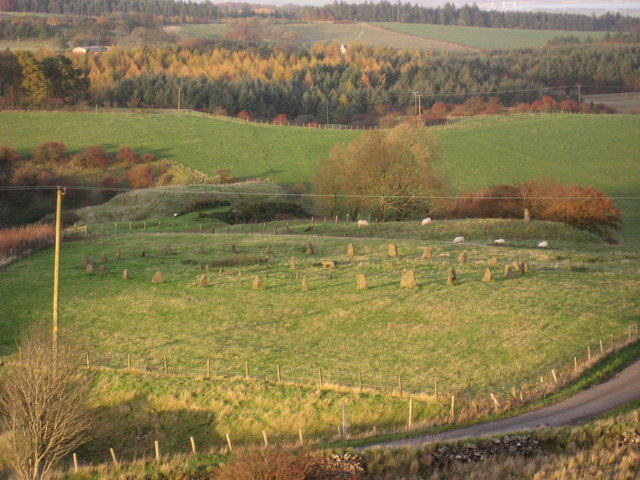
Knock Stone Circle submitted by Andy B on 12th Mar 2011. A faux stone circle, located by Knock in the Bathgate Hills, 2 miles (3 km) northeast of Bathgate in West Lothian. Comprising 50 stones, arranged in two concentric circles in a field by the roadside, the circle was built as a 50th Birthday surprise for the farmer by his son in 1998 and was undoubtedly inspired by the nearby Neolithic site at Cairnpapple Hill.
Copyright Chris Martin and licensed for reuse under this Creative Commons Licence.
(View photo, vote or add a comment)
Log Text: Knock Modern Stone Circle, West Lothian: Having passed this stone circle on the way to Cairnpapple, it looked impressive and I couldn’t wait to get back for a closer look. “Is this what a real stone circle looks like?” my friend (who is a relatively novice Megalith-hunter) asked. I chuckled as I read out the description from the Portal page which I’d printed off before I left home
It certainly looks as if it’s been here longer than 20 years!
The field was full of enormous sheep. The farmer has kindly built a small stile into the fence by the gate, which allowed us access into the field. We wandered round taking photographs. I really liked the little stone ‘seat’ in the inner ring, which the sheep gathered round.
I walked over to the outlier, which sits on a mound to the north-east of the circle.
On our way out, a car pulled out, parking half an inch from the bumper of our car. Out popped a photographer with a really big lens on his camera. He wandered up and down the road by the fence, taking photographs. We told him he could get into the field, either through the gate or over the stile. He said ‘thanks, but I’m waiting to get photos without the sheep’. As there were around 50 or so sheep in the field, I’m guessing he might have had some time to wait.
We headed off to Torphinchen for a snack and to visit the Preceptory (which was closed, even though the sign said it should have been open).
Cairnpapple Hill
Trip No.25 Entry No.1 Date Added: 21st May 2017
Site Type: Round Cairn
Country: Scotland (West Lothian)
Visited: Yes on 18th May 2017. My rating: Condition 3 Ambience 4 Access 4
Cairnpapple Hill submitted by ModernExplorers on 27th Mar 2013. A mound surrounded by smaller stones with holes, surrounded by a ditch and then more holes
(View photo, vote or add a comment)
Log Text: Cairnpapple Hill, West Lothian: Our first stop of the day, and I was really excited to visit this site after what I’ve read about it. We pulled up in the layby at NS 98968 71832 and made our way up the steps to the grassy field in which the cairn sits. My first reaction was ‘wow, look at those views – what a place to be buried’. The friend I was with told me we could see for 17-20 miles north and east.
At first, the mast in the farm nearby seemed to encroach upon the whole of the site, but as our visit progressed, I completely forgot it was there. The door to the Nissen hut was open, so I walked in clutching my ‘English Heritage’ cards to pay and buy a guide book from the gentleman inside. But, he told us he was an electrician, just there to carry out some tests; if the keys he had let us into the burial chamber proper, he would let us in. We followed him up the steps to the top of the mound, but sadly his keys wouldn’t open the black metal doors. What a shame!
We did, however, spent about an hour walking about the cairn (I was really disappointed to find out the dome was a modern construction, built to protect the burials), trying to understand it’s layout and the various stages of construction.
The interpretation boards said that the timber circle holes were filled with gravel, although there were others filled with grey/light brown gravel that were much bigger. I joked with my friend that the larger holes were big enough for crouch burials, so in fun, he demonstrated, with his mobile phone and glasses as his grave goods.
We could see the modern Knock Stone Circle in the distance. We said we’d go back with my friend and his wife when the visitor centre was open (Friday to Monday during summer months); she was brought up in the vicinity and knows the site well.
Torwood Broch
Trip No.24 Entry No.2 Date Added: 16th May 2017
Site Type: Broch or Nuraghe
Country: Scotland (Falkirk)
Visited: Yes on 13th May 2017. My rating: Condition 3 Ambience 4 Access 4
Torwood Broch submitted by cosmic on 23rd Sep 2005. View across broch to internal room.
(View photo, vote or add a comment)
Log Text: Tappoch/Torwood Broch, West Lothian: I’d wanted to go in search of the 2 boundary stones near Torphinchen, but was over-ruled in favour of the broch at Tappoch. By the time we’d left Torphinchen, the rain really started to come down, but being equipped with waterproofs, and supposedly sheltered by the tall forest trees, we set off anyway.
Parking on Glen Road, close to the footpath, we set off up the public right of way to Denoven (the car park that is mentioned in the main page is now a new house), then took the path which headed off right and up hill into the forest. It was lovely, soft spongy ground to walk on, with all the pine needles forming a soft covering over the prolific bedrock slabs.
Continuing up the hillside, the rain got heavier, but as we reached the broch, the rain stopped for a short period (just long enough for us to explore the broch).
The easiest way to access the interior of the broch is to take the path to your left, walking round the exterior wall of the broch. An internal staircase comes into view, and it’s easy walking down these few steps. Going straight up the hill was definitely for mountain goats! The interior feels roomy and solid, with sturdy, dry stone walls.
The foresters (or others) have clearly been using this structure, as there were the remains of a stone fire pit and recently burnt wood.
Looking closer at the lumps and bumps around the broch, I think there are other structures attached to this site. There was a very steep drop on the broch’s southern side, clearly excellent for defences.
Well worth a visit, even if it took several hours to dry out afterwards!
